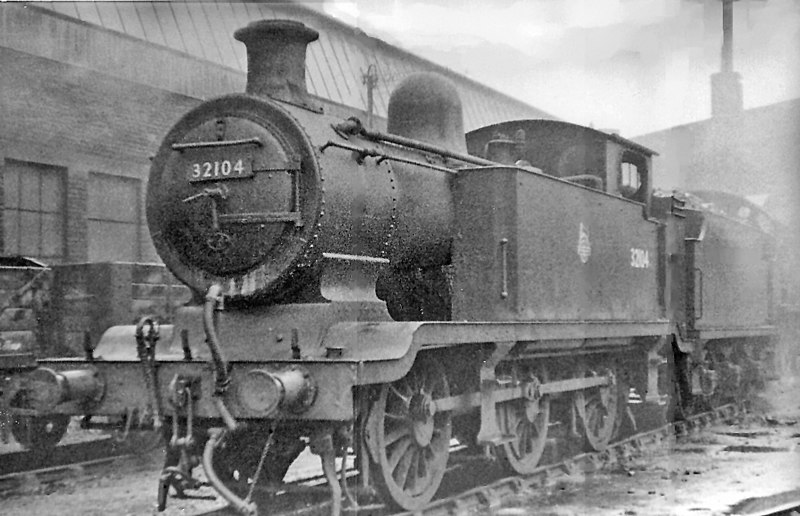I've covered some of the coolest planes in the past, but I'll never forget my favourite form of transport: the almighty steam train. Gradually superseded by diesel and electric locomotives in the 1960s, the steam train still remains a widespread innovation, establishing numerous records during it's lifetime and becoming one of the most iconic forms of transport; particularly in the UK where the most well known trains were built.
So, in another random post, let's take a look at just a few of the coolest trains and just why they're so famous...
LB&SCR E2 Class
The E2 tank engine was built between 1913 and 1916, with ten constructed in total. It was mainly intended as a station pilot and general shunting engine, preparing express trains and freight trains for larger locomotives. However, occasionally, these little guys did haul their own freight trains over short distances. They were surprisingly strong for their size, but small coal bunkers and limited boiler space made them inadequate for longer travels. They enjoyed a steady and surprisingly long career, lasting almost 50 years until their eventual retirement in the 1960s. Sadly, all were scrapped, leaving none to survive preservation and remain with us today.
Why is this engine so significant? Well, most people will recognise just why...of course, one of the most treasured children's characters of all time, Thomas the Tank Engine himself, is based on this class! But outside of that, they still have a reputation of their own, enjoying a lengthy career as useful and robust shunters that were a big step forward beyond their weaker predecessors, the E1 class.
LMS Stanier Class 5
William Stanier, one of the most notable steam train engineers, designed the LMS Stanier Class 5, nicknamed the Black Five, in order to provide mixed traffic services; that is, they are designed for both passengers and freight. They were introduced to the English railways in 1934 and production concluded in 1951, with a stellar total of 842 locomotives being built. It's widely considered a favourite amongst railway fans, thanks to impressive stats and a robust, iconic design. The Black Five was able to reach speeds of 75mph (though 50-60mph was more common), and was immensely strong, effortlessly hauling lengthy freight trains and express services. The year 1963 saw them widely withdrawn from service, and while the majority were scrapped, an unusually large eighteen of them remain in preservation on heritage railways and museums.
In terms of popular culture, the Black Five is the basis for Henry the Green Engine in The Railway Series and it's TV adaptation Thomas & Friends, who was rebuilt into one of these locomotives following an accident with a freight train dubbed The Flying Kipper.
LNER Gresley Classes A1 & A3
Sir Nigel Gresley was no stranger to fans of the railway industry - he built some of the most famous engines in history, which revolutionised mainline services with newly established stats of speed and strength. The A1 and A3 locomotives were relatively similar, with the latter sporting upgrades in boiler space and general size - in fact, only 27 of the 51 A3 locomotives were built from scratch, with the rest being A1's upgraded into improved specifications. A famous member of this class is the 4472 Flying Scotsman, named after the very train it hauled throughout it's entire career; a service that still runs today between Edinburgh and London. This beautiful beast became the first locomotive to reach 100mph in 1934, and also garnered a record for longest consistent journey whilst based in Australia in 1989 - where it hauled a passenger train across 422 miles without a single stop.
Flying Scotsman is universally considered the most famous steam locomotive in history, and one that, again, revolutionised the railway industry alongside other members of the class. Sadly, it is the only preserved member, with all others being scrapped in the 1960s.
LNER Class A4
One of the most iconic locomotives of all time, the Class A4 was designed by Sir Nigel Gresley (one locomotive of which is named after him) for the purposes of providing even faster express services on the English main line. Notably, one member of this class, 4468 Mallard, holds the record for fastest steam locomotive in history - reaching 126mph at Stoke Bank in 1938. Their streamlined body was the key to their outstanding speed; world records aside, the locomotives also added general convenience to most passenger journeys, shredding off lengthy journeys around the Scottish mainline by well over half an hour. They occasionally hauled freight trains, but for the majority of their prosperous lifespan, these locomotives became notable for establishing high speed express services as something that could evolve into something faster and faster for years to come.
A total of 35 of these trains were built between 1935 and 1938, and they retired from service in the early, you guessed it, 1960s. The majority were scrapped, but six remain preserved, most notably the aforementioned Mallard and the equally renowned 4498 Sir Nigel Gresley.
Thanks for reading!


